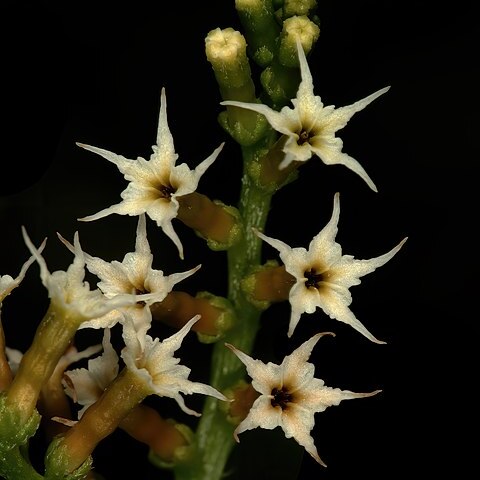Perennial herb, much branched from a woody base, 0.2-0.8 m high. Stems erect. Leaves petiolate; blade ovate to elliptic, 10-30 x 2-10 mm, slightly decurrent, base cuneate, apex acute, margin undulate, shallowly toothed, lower leaf blade with bulbous-based setae, upper part of seta short and stout; petioles 3-12 mm long. Flowers: in helicoid cymes, ebracteate; upper part of style head cylindrical; calyx pubescent, persistent, deeply lobed, much shorter than corolla, lobes triangular; corolla white, throat orange, tube cylindrical, ± 3.5 mm long, appressed pubescent in upper part, lobes acuminate, ± 1.5 mm long; Oct.-May. Fruit 2 nutlets, rugose, tuberculate-crested, saddle-shaped at apex, connate in pairs.
Leaves usually sparse; petiole 2–20(25) mm. long, with hair-covering like the branches; lamina 20–50 x 5–20 mm., lanceolate or ovate, with hard short appressed hairs above and on the nerves below, covered with the swollen bases of minute hairs below, rarely roughish on both surfaces, acute to obtuse and sometimes mucronate at apex, acute to obtuse, decurrent on the petiole and often asymmetrical at base, margins usually repand and undulate.
Corolla hypocrateriform, white, sparsely strigose outside on the upper part, otherwise glabrous outside and inside; tube 3.5–5.0 mm. long, slightly widened in the upper half; limb 3–5(6) mm. in diam.; lobes 1.2–2.2(2.5) mm. long, triangular-acuminate, usually with undulate and ± crenate margins, bent inwards in bud, spreading.
Perennial herb, much branched from a woody base, 0.2-0.8 m high. Stems erect. Leaves petiolate; blade narrowly ovate to ovate; petioles 3-12 mm long. Flowers in helicoid cymes. Calyx much shorter than corolla. Corolla white, throat orange. Flowering time Oct.-May. Fruit of glabrous, rugose nutlets.
Erect perennial herb, up to 0.8 m high. Hairs on stem appressed. Calyx lobes thick, callose. Corolla lobes acuminate, tube long. Fruit tuberculate-crested, saddle-shaped at apex; nutlets connate in pairs. Flowers white.
Calyx minute, callose-strigose or subglabrous outside, subglabrous or glabrous inside; lobes 0.5–1.0(2.0) mm. long, ovate to ovate-triangular, acute, callose-ciliate mainly at the base, thick.
Style 1.0–1.5(2.0) mm. long, filiform, glabrous; stigmatic ring not very well marked; sterile appendix 1.0–1.4 mm. long, narrowly conical, deeply 2-lobed, hirtellous.
Fruits c. 4 x 5 x 4 mm., saddle-shaped at apex, tuberculate-crested, glabrous; nutlets connate in pairs, each pair 2-horned, 2-seeded, with the inner surface flat.
Stamens inserted about the middle of the corolla tube; anthers 1.2–1.5 mm. long, narrowly oblong, emarginate at apex, obtuse to subcordate at base, subsessile.
Stem usually branched from the base, somewhat swollen below the branches insertions, angular as for the branches with short appressed hairs.
Cymes lax, up to 19 cm. long when completely expanded, usually 2, rarely single, terminal; common peduncle 1–4 cm. long.
Erect rhizomatous perennial herb up to 80 cm. high.
Flowers sessile or subsessile.
Ovary glabrous.

